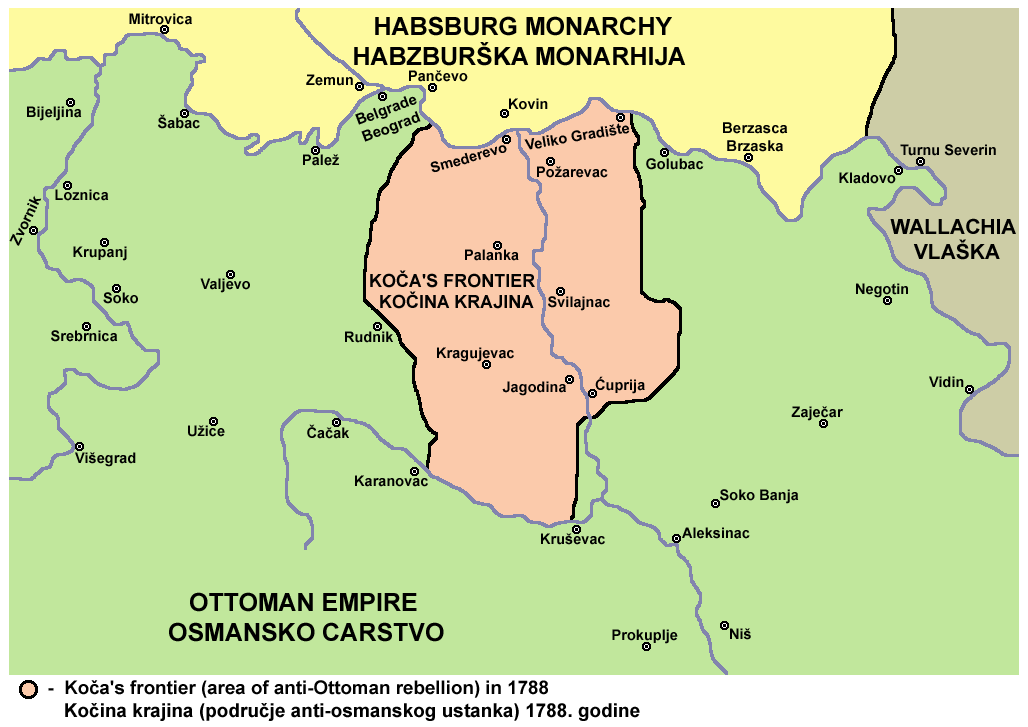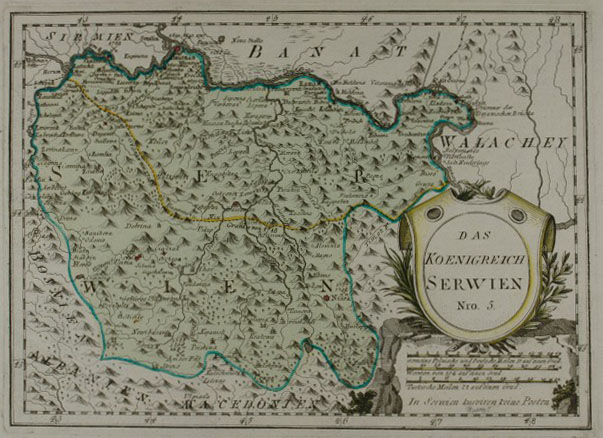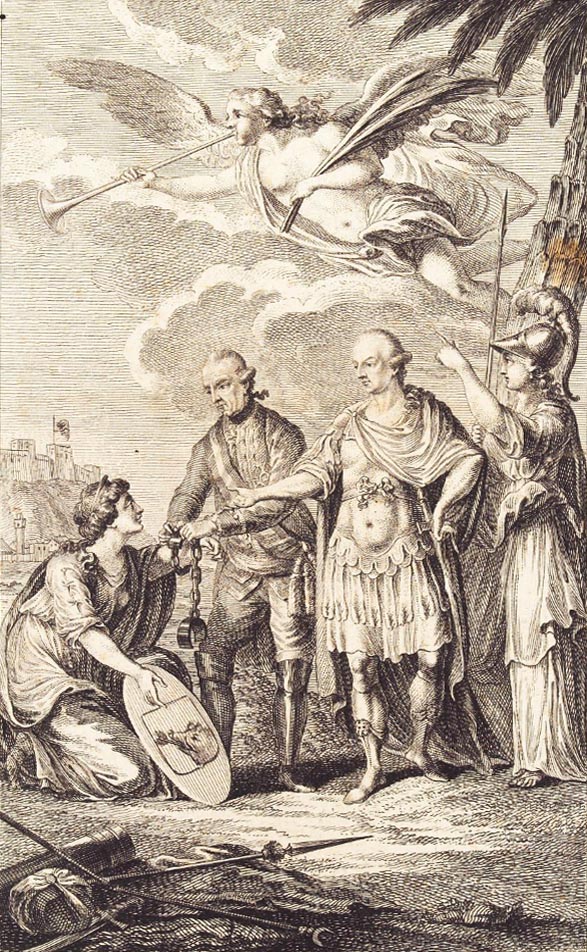Habsburg-occupied Serbia (1788–1792) on:
[Wikipedia]
[Google]
[Amazon]
Koča's frontier ( sr, Кочина крајина / ''Kočina krajina'') refers to the Serbian territory established in the

 A
A
 On 8 October 1789,
On 8 October 1789,
Sanjak of Smederevo
The Sanjak of Smederevo ( tr, Semendire Sancağı; sr, / ), also known in historiography as the Pashalik of Belgrade ( tr, Belgrad Paşalığı; sr, / ), was an Ottoman Empire, Ottoman administrative unit (sanjak), that existed between the 1 ...
, Ottoman Empire
The Ottoman Empire, * ; is an archaic version. The definite article forms and were synonymous * and el, Оθωμανική Αυτοκρατορία, Othōmanikē Avtokratoria, label=none * info page on book at Martin Luther University) ...
, during the Austro-Turkish War (1787–1791) The term Austro-Turkish War may refer to:
* Austro-Turkish War (1593–1606)
* Austro-Turkish War (1663–1664)
* Austro-Turkish War (1683–1699)
* Austro-Turkish War (1716–1718)
* Austro-Turkish War (1737–1739)
* Austro-Turkish War (1788–17 ...
. The Habsburg-organized Serbian Free Corps
The Serbian Free Corps (german: Serbische Freikorps), known simply as ''frajkori'' ( sr-cyr, фрајкори), was a volunteer militia composed of ethnic Serbs, established by the Habsburg monarchy, to fight the Ottoman Empire during the Austro-T ...
, among whom Koča Anđelković
Korun "Koča" Anđelković ( sr-cyr, Коча Анђелковић, 1755 – 7 September 1788), known as Captain Koča (Kapetan Koča), was a Serbian leader of the Serbian Free Corps, the Habsburg military unit that fought the Ottomans during ...
was a prominent captain (hence the historiographical name), initially held the central part of the sanjak, between February and September 7, 1788; after the Austrians entered the conflict the territory was expanded and became a Habsburg protectorate under military administration, called Serbia (german: Serbien). After the Austrian withdrawal and Treaty of Sistova
The Treaty of Sistova ended the last Austro-Turkish war (1787–91). Brokered by Great Britain, Prussia and the Netherlands,''The Peace Treaties of the Ottoman Empire'', Karl-Heinz Ziegler, Peace Treaties and International Law in European Histo ...
(1792), the territory was regained by the Ottomans.
Background
Serbs
The Serbs had taken an active part in the wars fought in the Balkans against the Ottoman Empire, and also organized uprisings. Because of this, they suffered persecution and their territories were devastated. Major migrations from Serbia into Habsburg territory ensued.Habsburg-Russian alliance
Due to conflicts around Caucasus in 1786, relations between Russia and the Ottomans soured. The next year,Joseph II
Joseph II (German: Josef Benedikt Anton Michael Adam; English: ''Joseph Benedict Anthony Michael Adam''; 13 March 1741 – 20 February 1790) was Holy Roman Emperor from August 1765 and sole ruler of the Habsburg lands from November 29, 1780 unt ...
and Catherine II
, en, Catherine Alexeievna Romanova, link=yes
, house =
, father = Christian August, Prince of Anhalt-Zerbst
, mother = Joanna Elisabeth of Holstein-Gottorp
, birth_date =
, birth_name = Princess Sophie of Anha ...
met in Crimea for the second time, which prompted the Ottomans to declare war on Russia. In the meantime, the Austrians prepared the Serb refugees for war.
History
Koča's frontier rebellion

 A
A Serbian Free Corps
The Serbian Free Corps (german: Serbische Freikorps), known simply as ''frajkori'' ( sr-cyr, фрајкори), was a volunteer militia composed of ethnic Serbs, established by the Habsburg monarchy, to fight the Ottoman Empire during the Austro-T ...
of 5,000 soldiers had been established in Banat, composed of refugees that had fled earlier conflicts in the Ottoman Empire. The Corps would fight for liberation of Serbia and unification under Habsburg rule. The main commander was the Austrian major Mihailo Mihaljević. Among volunteers were Aleksa Nenadović
Aleksa Nenadović (1749 Brankovina, Valjevo, Serbia — 4 February 1804, Valjevo, Serbia) was ober knyaz of Tamnava—Posavina district of Valjevo nahiyah of the Belgrade Pashaluk.
Family
Aleksa Nenadović was member of Nenadović family from Va ...
, Stanko Arambašić Stanko Arambašić ( sr-Cyrl, Станко Арамбашић; Levač in the village of Kolare, Ottoman Empire, today Serbia, 1764 - Smederevo, Ottoman Empire, 21 September 1798) was a Serbian Free Corps commander who liberated parts of Serbia dur ...
, Karađorđe Petrović
Đorđe Petrović ( sr-Cyrl, Ђорђе Петровић, ), better known by the sobriquet Karađorđe ( sr-Cyrl, Карађорђе, lit=Black George, ; – ), was a Serbian revolutionary who led the struggle for his country's independ ...
, the prominent Radič Petrović
Radič Petrović ( sr-cyr, Радич Петровић; 1738–1816), known as Captain Radič (''kapetan Radič''), was a Serbian Revolutionary commander (''vojvoda''), earlier a Military Frontier guard and volunteer in the Austro-Turkish War ( ...
and most of all, Koča Anđelković
Korun "Koča" Anđelković ( sr-cyr, Коча Анђелковић, 1755 – 7 September 1788), known as Captain Koča (Kapetan Koča), was a Serbian leader of the Serbian Free Corps, the Habsburg military unit that fought the Ottomans during ...
. The Austrians used the Corps in two failed attempts to seize Belgrade, in late 1787 and early 1788.
The Austrians entered this war in February 1788, though they had by now lost their best chance for an easy victory. The slow preparations of Russia resulted in the Ottoman concentration on Belgrade. The Austrians relied on Russian support in Moldavia, which only began in late 1788, and Joseph II seemed to have been reluctant to fight the Ottomans. In July, the Ottomans crossed the Danube and broke into Austrian Banat. Shortage of supplies struck both sides, while disease struck the Austrian soldiers. As many as 50,000 Serb refugees flooded across the Danube, causing logistical problems for the Austrians. In mid-August, Joseph II dispatched 20,400 soldiers into Banat.
Habsburg occupation
 On 8 October 1789,
On 8 October 1789, Ernst Gideon von Laudon
Ernst Gideon von Laudon, since 1759 Freiherr von Laudon (originally Laudohn or Loudon; 13 February 171714 July 1790), was a Baltic German-born Austrian generalisimo and one of the most successful opponents of the Prussian king Frederick the Great ...
took over Belgrade. Austrian forces occupied Serbia, and many Serbs fought in the Habsburg free corps, gaining organization and military skills. The occupation was accompanied by the Catholic Church which sought to convert the Orthodox Serbs, which made the Serbs look to Russia for aid after the Ottoman regaining of the area in 1792.
By 1791 however the Austrians (the Habsburg
The House of Habsburg (), alternatively spelled Hapsburg in Englishgerman: Haus Habsburg, ; es, Casa de Habsburgo; hu, Habsburg család, it, Casa di Asburgo, nl, Huis van Habsburg, pl, dom Habsburgów, pt, Casa de Habsburgo, la, Domus Hab ...
) were forced into withdrawal across the Danube
The Danube ( ; ) is a river that was once a long-standing frontier of the Roman Empire and today connects 10 European countries, running through their territories or being a border. Originating in Germany, the Danube flows southeast for , pa ...
and Sava
The Sava (; , ; sr-cyr, Сава, hu, Száva) is a river in Central and Southeast Europe, a right-bank and the longest tributary of the Danube. It flows through Slovenia, Croatia and along its border with Bosnia and Herzegovina, and finally th ...
rivers, joined by thousands of Serbian families who feared Ottoman persecution. The Treaty of Sistova
The Treaty of Sistova ended the last Austro-Turkish war (1787–91). Brokered by Great Britain, Prussia and the Netherlands,''The Peace Treaties of the Ottoman Empire'', Karl-Heinz Ziegler, Peace Treaties and International Law in European Histo ...
ended the war.
Aftermath
After the war, the Ottomans gave rights to the Serbs to collect local taxes. The displacedjanissaries
A Janissary ( ota, یڭیچری, yeŋiçeri, , ) was a member of the elite infantry units that formed the Ottoman Sultan's household troops and the first modern standing army in Europe. The corps was most likely established under sultan Orhan ( ...
, excluded from the Ottoman Army following reorganization, sought refuge in Serbia (Sanjak of Smederevo
The Sanjak of Smederevo ( tr, Semendire Sancağı; sr, / ), also known in historiography as the Pashalik of Belgrade ( tr, Belgrad Paşalığı; sr, / ), was an Ottoman Empire, Ottoman administrative unit (sanjak), that existed between the 1 ...
) where they tried to revoke the rights granted to the Serbs. These renegade janissaries, called ''dahije
The Dahije ( sr-cyr, Дахије) or Dahijas were the renegade Janissary officers who took power in the Sanjak of Smederevo (also known as the Belgrade Pashaluk), after murdering the Vizier Hadži Mustafa Pasha of Belgrade on 15 December 1801. Th ...
'', murdered as many as 150 Serb leaders (''knezovi''), sparking the First Serbian Uprising
The First Serbian Uprising ( sr, Prvi srpski ustanak, italics=yes, sr-Cyrl, Први српски устанак; tr, Birinci Sırp Ayaklanması) was an uprising of Serbs in the Sanjak of Smederevo against the Ottoman Empire from 14 February 18 ...
(1804). The leader of the uprising, Karađorđe Petrović
Đorđe Petrović ( sr-Cyrl, Ђорђе Петровић, ), better known by the sobriquet Karađorđe ( sr-Cyrl, Карађорђе, lit=Black George, ; – ), was a Serbian revolutionary who led the struggle for his country's independ ...
, had earlier served in the Austrian army as a volunteer during the Habsburg occupation. The uprising expanded into the Serbian Revolution
The Serbian Revolution ( sr, Српска револуција / ''Srpska revolucija'') was a national uprising and constitutional change in Serbia that took place between 1804 and 1835, during which this territory evolved from an Ottoman prov ...
(1804–17), which saw the ''de facto'' independence of Serbia
Serbia (, ; Serbian language, Serbian: , , ), officially the Republic of Serbia (Serbian language, Serbian: , , ), is a landlocked country in Southeast Europe, Southeastern and Central Europe, situated at the crossroads of the Pannonian Bas ...
.
Legacy
An annual manifestation, the "Days for Koča's Frontier" (Дани Кочине крајине), takes place inJagodina )
, image_shield = Jagodina-grb.png
, image_flag = FLAG Jagodina.png
, image_skyline =
, image_caption =
, image_map = File:Municipalities of Serbia Jagodina.png
, map_caption = Location of Jagodina w ...
and Kladovo
Kladovo ( sr-Cyrl, Кладово, ; ro, Cladova or ) is a town and municipality located in the Bor District of Southern and Eastern Serbia, eastern Serbia. It is situated on the right bank of the Danube river. The population of the town is 8,91 ...
in honour of the rebellion.
See also
* Habsburg-occupied Serbia (disambiguation) * Battle of Mainz, neutral Serbian observersReferences
Further reading
* * * * * * * * * * * * {{DEFAULTSORT:Habsburg-occupied Serbia (1788-92) Rebellions against the Ottoman Empire Conflicts in 1788 Wars involving the Ottoman Empire 1780s in the Ottoman Empire 18th century in Serbia Ottoman Serbia Serb rebellions Serbia under Habsburg rule Habsburg Serbs 1788 establishments in the Habsburg Monarchy 1792 disestablishments in the Habsburg Monarchy Austro-Turkish Wars Occupation of Serbia 1790s in Serbia 1780s in Serbia